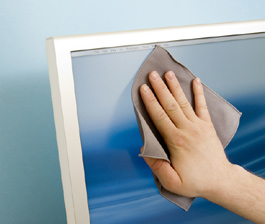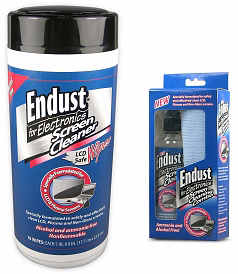 These Flat Panel Displays are quite different from their older CRT counterparts, even when it comes to cleaning. Since CRTs had a glass screen, they could pretty much be cleaned much like any other glass surface in your home or office using the same types of chemical cleaners.
These Flat Panel Displays are quite different from their older CRT counterparts, even when it comes to cleaning. Since CRTs had a glass screen, they could pretty much be cleaned much like any other glass surface in your home or office using the same types of chemical cleaners.
But Desktop LCD Monitors and Laptop Screens are physically more sensitive than CRTs and can easily be damaged with chemicals, so they require special care when cleaning. But they are still pretty easy to clean. These same procedures can also be used for LCD TVs as well.
For best results, view the VIDEO above in “Full Screen”.
How to Clean LCD Displays
Turn off the Display (for Laptops, shut down and pull the battery so it doesn’t come on accidentally). When the screen is off, it will be easier to see any dust, fingerprint smudges, and oily areas on the screen.
- For Laptops, I suggest you clean the keyboard first, as dust and foreign particles in the keyboard will get on the screen once you close the lid, especially after handing. See the video on how to clean Laptop Keyboards for more info.
- Always open and close a Laptop LCD Display by handling by the center of the screen or by “both” corners, NEVER just by one corner, as this may cause a broken hinge in the future due to uneven torque on the mounting hardware, particularly the left hinge.
 Use a soft, dry cloth (such as microfiber cloth used to clean eyeglasses) and very gently wipe the screen. Always use a clean cloth, as tiny, hard particles trapped in the fibers can scratch the surface of your screen.
Use a soft, dry cloth (such as microfiber cloth used to clean eyeglasses) and very gently wipe the screen. Always use a clean cloth, as tiny, hard particles trapped in the fibers can scratch the surface of your screen.
- Avoid using paper towels, toilet paper, tissue paper, or your shirt to wipe the screen, as these materials might scratch the display.
- If the dry cloth did not completely remove the dirt or oil, do not press too hard trying to scrub it off. Pushing down to hard on the screen can cause pixels to burn out, resulting in permanent dark or colored dots on your screen.
- If necessary, use a small, clean spray bottle filled with “distilled” water to dampen a clean microfiber cloth, and carefully wipe the screen again. Then use a clean, dry microfiber cloth to dry the screen. Avoid getting moisture in any openings.
Note 1: Do not use tap water! Doing so will leave white smears on your screen from the dissolved minerals in the water.
Note 2: Never spray liquid directly on an LED, LCD, or plasma screen. It could run inside the monitor and cause damage.
Note 3: Avoid cleaning products that contain ammonia, ethyl alcohol, acetone, toluene, ethyl acid, or methyl chloride. These chemicals can react with the materials the screen is made of which can cause yellow discoloration and other kinds of surface damage.
- The plastic edge that surrounds the screen (LCD Display Bezel) can be cleaned with most any multipurpose cleaner but take extreme care to avoid contact with the screen itself.
- If you feel you need to use more than just “distilled water” to clean your screen, you can use some store-bought LCD Cleaning Solution or Wipes, or you can make your own solution with a 50/50 mixture of Isopropyl Alcohol and Distilled Water. Just beware of using too much alcohol because it may damage your screen.
- In my opinion, I would try to avoid using any chemicals, especially when cleaning Touchscreens.
- Wash and dry your microfiber cloth as necessary and store them in a ziplock bag to keep clean. Replace your microfiber cloth when it loses its softness.
Touchscreens
Touchscreens, such as on Touchsmart PCs and Tablets are easy to clean but are very sensitive to chemicals. I would recommend cleaning them with a very soft cloth dampened with water followed by a wipedown using a microfiber cloth.
For example, the oleo-phobic coating (sometimes known as anti-scratch coating) on iPad Touchscreens is designed to protect the display, making it easier to clean and to eliminate the need for using any chemical cleaning solutions. The iPad user guide warns against using window cleaners, household cleaners, aerosol sprays, solvents, alcohol, ammonia, or abrasives to clean the iPad screen. Cleaning your iPad Touchscreen with abrasive materials will diminish the effect of the oleo-phobic coating and may scratch the screen.
If you keep your screen clean from the beginning, it will be very easy to maintain from then on. But if you have neglected your screen for some time already, you may have some permanent discoloration and smudges in some areas of your screen even after cleaning. But you can still improve the overall appearance of the screen by regularly cleaning your screen from now on.